In this month’s issue:
An itch-free guide to identifying poison ivy before you need the calamine lotion
Safety tips for getting in a good hike despite the summer heat
It’s practically a berry of the month club here — keep scrolling for blackberry content
My recommendation for a quick summer read on John James Audubon (yes, the old, dead bird guy)
Plus a few other nature notes.
Good morning, campers!
The big summer holidays have come and gone — Memorial Day, Juneteenth, and Independence Day — so what do we do with the remainder of summer? Frankly, I’d love to spend these hot and hazy days at an adult summer camp. I want a mess hall that isn’t my kitchen, with no KP duties required. I want to make beaded bracelets to share with my friends (big respect to all you Swifties out there doing the damn thing). I want a chance to improve my track record of flipping a canoe nearly every time I spend an afternoon floating.
We Americans may be nostalgically obsessed the idea of summer sleepaways. There’s no limit to the number of campy movies set featuring shabby cabins and after-dark talent shows, like Troop Beverly Hills, Moonrise Kingdom, and Wet Hot American Summer. I’d be remiss if I didn’t include The Parent Trap — the original 1961 film and the Millennial cult-classic version featuring Lindsay Lohan. I’m not sure why summer camp has such a hold on American culture, but it could be that a few weeks away from home exploring the outdoors and making friends gave many of us a chance to be our truest selves without the pressures of everyday life.
When writing this month’s Outdoor Humans, I thought: Why not spend one perfect day at summer camp? The ideas in this month’s issue don’t require you to pitch a tent in your backyard, but no one’s stopping you. Just don’t forget to shake out your sleeping bag before climbing in for the night.
P.S.: If you’re a fellow Millennial camper who never got the hang of making those awesome pony bead animal keychains, here’s your chance. Check out this step-by-step tutorial.
This month, outdoors
Raise the camp flag and get to the mess hall for breakfast — Outdoor Humans is helping you spend one day at summer camp. Let’s go!
🌿 Poison Ivy 101 (This Post Not Sponsored By Bell Biv DeVoe)
Let’s start the day with a little nature lesson that will serve you well here at camp.
I have a confession: I’ve never gotten poison ivy. It’s not from a lack of trying. Growing up on a 20-acre farm and summers at Girl Scout camp practically guaranteed a few rubs against poison ivy, yet I’ve never gotten a rash. My dad and brothers are also immune from this pesky plant (my poor mom is the sole member of the Sad and Itchy Club™). We might be freaks of nature, or we could have great genetics — about 15% of Americans aren’t allergic to poison ivy.
What a flex, right? Unfortunately, this magical trait does have a disadvantage: I’m terrible at picking poison ivy out of a lineup. It doesn’t pop out to me when hiking with kids or friends, so I can’t warn them to avoid it. Forgetting what it looks like means I easily contaminate my clothes or hands with urushiol — aka the irritating oil that causes poison ivy’s allergic reaction — and can then spread it to my very allergic (and lovingly patient) husband.
Getting that horribly itchy, weepy rash is practically a summer camp right of passage — so as your friendly camp counselor, I thought we’d learn together how to avoid it. Who should I turn to for a primer on identifying this hellacious plant? Why not David Meeker, a natural resource steward who’s spent more than a decade working outdoors… and who may or may not be the aforementioned itchy spouse tasked with pointing out poison ivy on every hike.
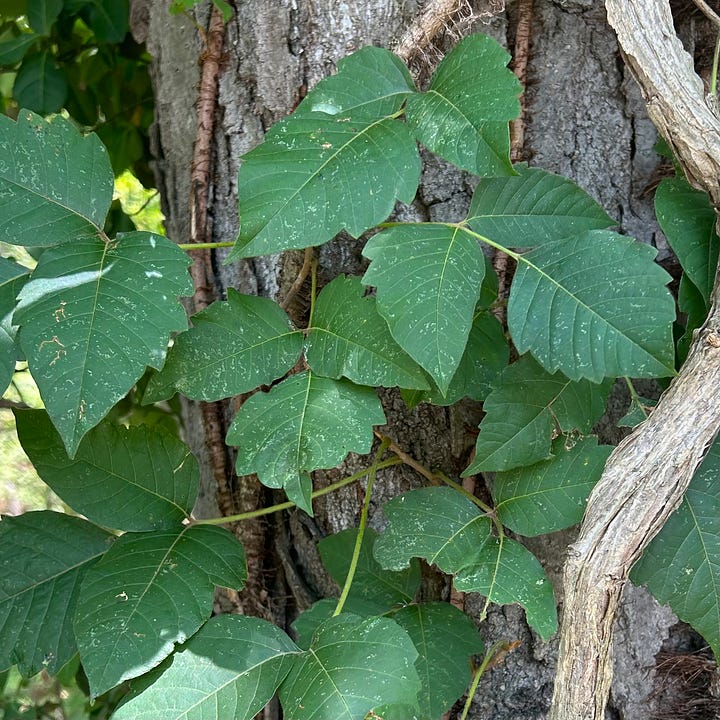
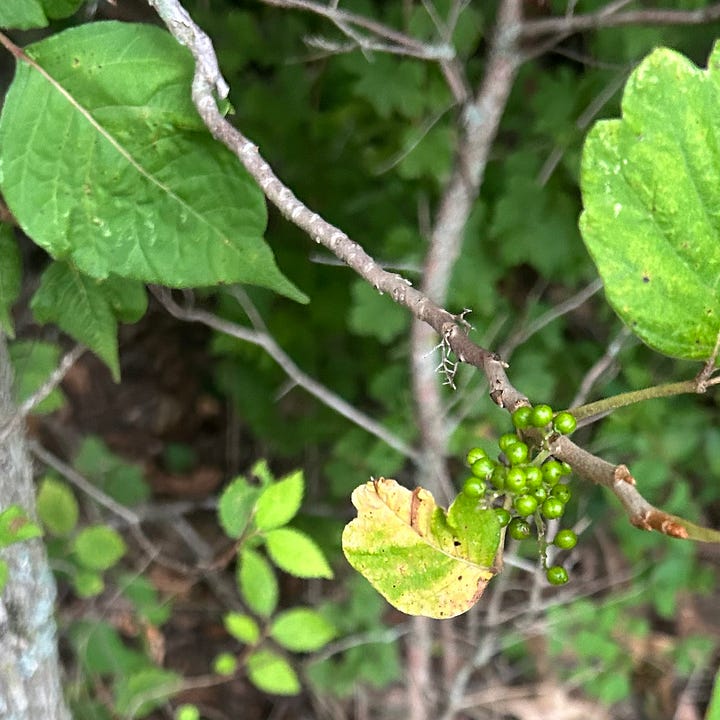
Characteristics of Poison Ivy
David and I took a walk with the express intent of finding and identifying poison ivy. Here’s what he pointed out to me:
“Leaves of three, let it be” is outdoor wisdom that holds up. Poison ivy has a grouping of three leaflets. The center leaf is symmetrical and has an elongated stem. The two side leaves are asymmetrical, and as David has repeated for nearly 14 years, resemble a pair of mittens. One side of the leaf is smooth while the other has a thumb-like or jagged edge.
Poison ivy can appear as a small single plant, will grow vigorously into a shrub, and will wrap itself around trees in vines reaching upwards of 60 feet.
As fall approaches, the leaves of poison ivy can change colors, transitioning from green to yellow, orange, or red.
Poison ivy also blooms! Its flowers appear in the spring and early summer, and the plant produces green berries that turn white as they ripen.
A Few Poison Ivy Imposters
You’re probably on high alert looking for poison ivy everywhere, but there are a few impersonators that may catch you off guard. Every time I said “Surely, this is poison ivy,” this poor man sighed and explained why it is not.
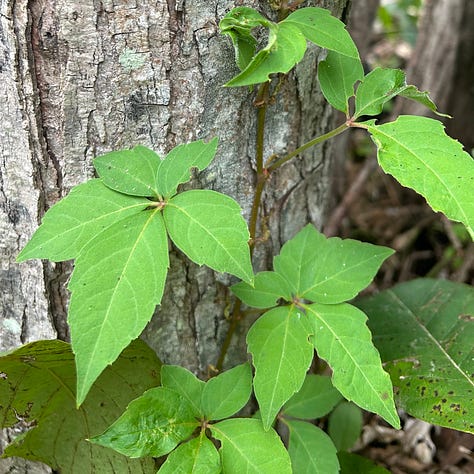


Virginia Creeper (Parthenocissus quinquefolia) climbs and wraps itself around trees like vining poison ivy. It can have three leaflets, but often has five.
Box elder maple (Acer negundo) saplings tricked me. These small trees often have three leaflets but can have up to 7. Their stem is typically a waxy blue-white hue, and they look less menacing as they grow.
Fragrant sumac (Rhus aromatica) wasn’t spotted on our nature walk, but is commonly confused. It grows as a thick shrub and has dark brown bark and red berries.
Spotting poison ivy takes practice, and sometimes you’ll still miss it. The best thing to do after a hike through the woods is washing your hands, and tossing outdoor clothes straight into the washer. Sometimes you still wind up with a rash, but what would you rather do — sit inside all day? Grab the calamine lotion and keep moving. 🌿
🥾 Hiking When It Feels Like 199° Out There
As my current obsession pop singer Chappell Roan would say, “Is anyone else hot?” Let’s hit the trail and find out.
Ready your daypacks, campers, because the best time to get out on a summer hike is early in the day. Hiking can take the wind out of you on even the best-weather days, but clocking in miles during the hottest part of summer takes some extra precautions. Here’s how to stay cool for a great time on the trail.
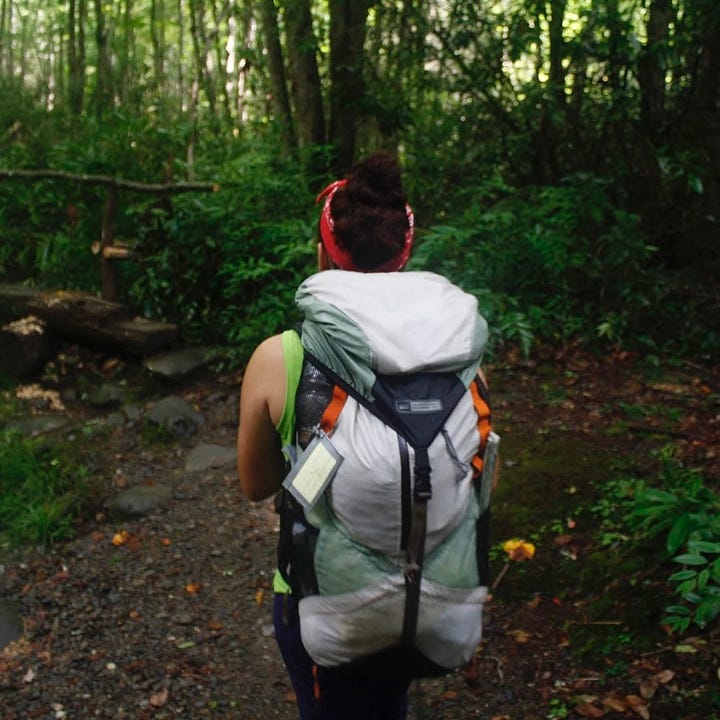
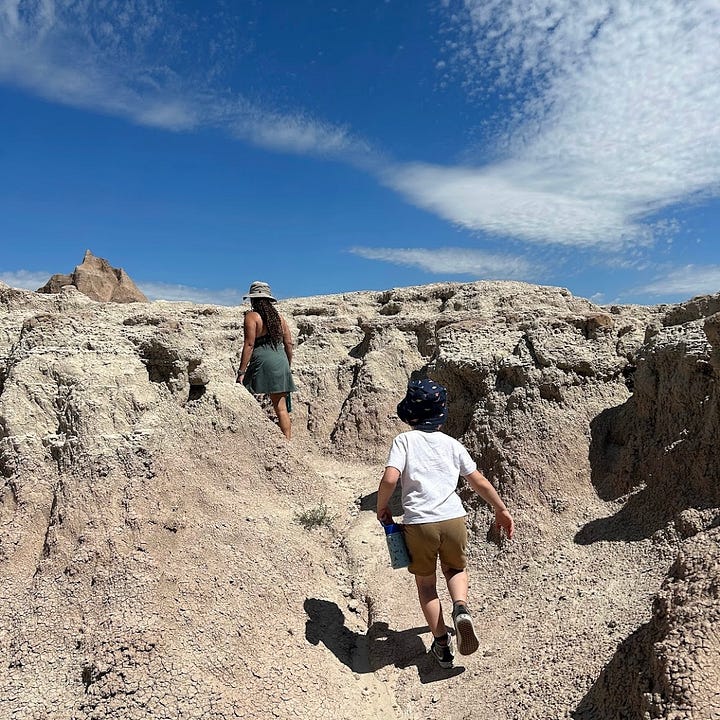
Trek the right trail at the right time
Embarking on a hike at 8 a.m. on a 90-degree day is vastly more enjoyable than heading out after noon. Head out early in the day or later in the afternoon, and select a trail that limits sun exposure. Shaded trails can be noticeably cooler, and hikes along creeks gives you the option to jump in and cool down.
Opt for comfortable activewear
Many backpackers are devoted to the phrase “cotton kills” — wet cotton takes forever to dry and holds moisture close to your body, which causes chafing at best and (wintertime) hypothermia at worst. There are a lot of disputes about this within the hiking community, but the takeway here is moisture-wicking clothes can make your hot-weather hikes more comfortable.
Pack smart
The heavier your daypack, the more exhausted you’ll be lugging it on a long hike. Tailor your essentials based on your selected hike, and be sure to pack more water than you think you’ll need.
Take care of yourself
You’ve gotta practice self-care in the woods, friends. Warm-weather hiking means more sweating and more hydration. Don’t forget regular sunscreen application. Expect to move slowly in the heat and take more trailside breaks. The goal isn’t to hike fast, but to enjoy the view regardless of how far you go.
Know the signs of a bad time
The trail ahead is occasionally too perilous, sometimes due to intense heat. Even the most sun-loving outdoor humans can have a run-in with heat exhaustion or heat stroke. Nausea, vomiting, headaches, cramps, and cool, moist skin can be signs of heat exhaustion (which are treated with rest, cooling down, and drinks with added electrolytes). Heat stroke can cause a weak or rapid pulse, confusion, unconsciousness, seizures, and even mimic a heart attack — these symptoms require immediate medical attention. The best way to hike safely this summer might be hitting the trail with a friend so you can share the views while looking out for each other. 🥾
🧺 I’m Really Just Here for the Berries
Drop the GORP. The woods have something better.
June’s issue had a thorough explainer on harvesting mulberries, but now the true queen of berry season has arrived. Blackberries are ripening this month and ready for picking. If you’ve never hunted for wild blackberries, these plant notes from the Virginia Dept. of Forestry are helpful (see PDF page 67).
When to hunt: Late June through August
Blackberry brambles began blooming back in April, and now it’s time to harvest the sweet efforts of all that pollination work. The earliest berries ripen in late June, though production typically peaks in July and tapers off in August. It takes just a few days for berries to ripen, so if the thorny canes (aka branches) you encounter are covered in green berries, hold off. Blackberries will not ripen after harvest, so check back daily until they’re ready.
Where to look: Practically everywhere
Blackberry plants aren’t picky you can find them nearly anywhere: in fields and open valleys, along woodlines and fencerows, even creeks and roadsides. Sometimes you’ll find bare blackberry canes. They may have been picked clean… or they could be too young. While the plant’s crowns (aka main rooting structure) can live for years, the individual canes last only two seasons. First-year canes have green or red branches, and since the plant is focused on growth, there won’t be any fruit to collect. Second-year canes, which finally flower and fruit before they die, are darker brown and may feel like woody stems.


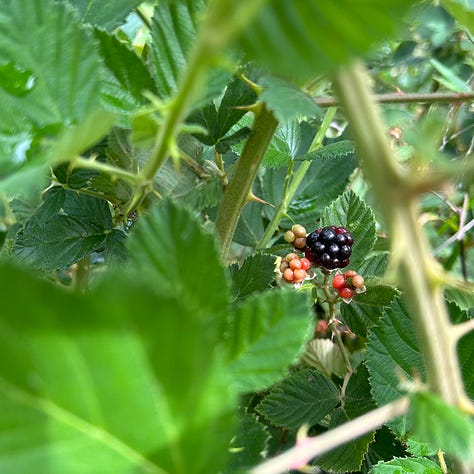
How to harvest: Every berry has its thorns
There’s a hard truth to picking blackberries: you’re going to get prickled a lot. But in some masochistic way, it seems to make the berries taste better. I use a stick to lift the canes out of the way so that I can get closer with fewer stabs, and can access the undersides of brambles where big, juicy berries tend to hide.
Using your blackberry harvest
Like store-bought berries, fresh blackberries won’t last long. I find they often mysteriously disappear before getting back to the car or home. A big harvest will keep for about a week if refrigerated. There’s a ton you can do with them (jam, cobbler, parfaits), though one of my favorite recipes includes heating them with chocolate over a campfire.
Blackberry Campfire Cones
Ingredients:
Waffle or sugar cones
Mini marshmallows
Mini chocolate chips or small pieces of milk chocolate
Blackberries
Stuff the waffle cones with a marshmallows, chocolate chips, and berries in a ratio to your liking. Wrap each cone individually in aluminum foil, and place on a rack over your campfire. Cones are ready to eat when the chocolate and marshmallows have melted (about 5 minutes). This recipe is an easy-to-assemble dessert for weekend campouts, and it’s particularly great for smaller campers who find s’mores too messy. Didn’t find any blackberries on your hike? You can sub in any fruit to customize this recipe to your liking. 🧺
🔭 An Evening at Summer Camp, Under The Stars
Round out the evening with nature’s very own fireworks.
Would it be a complete day at summer camp without a little stargazing? July is the perfect time to turn towards the skies and catch a meteor shower. The Perseids and Southern Delta Aquariids — two meteor showers active this time of year — are visible over the next month.
A little refresher on meteor showers
Shooting stars aren’t actually stars. Instead, they’re meteors: chunks of ice or rock that can be as large as a boulder or as tiny as a speck of sand. All that cosmic clutter — what scientists call “meteoritic material” — constantly enters our atmosphere, and when it does, it becomes so hot it burns up. The “shooting” streak we see is the incredibly hot air surrounding the meteor as it falls, and when there’s a lot happening at once, voila, a full-on meteor shower.
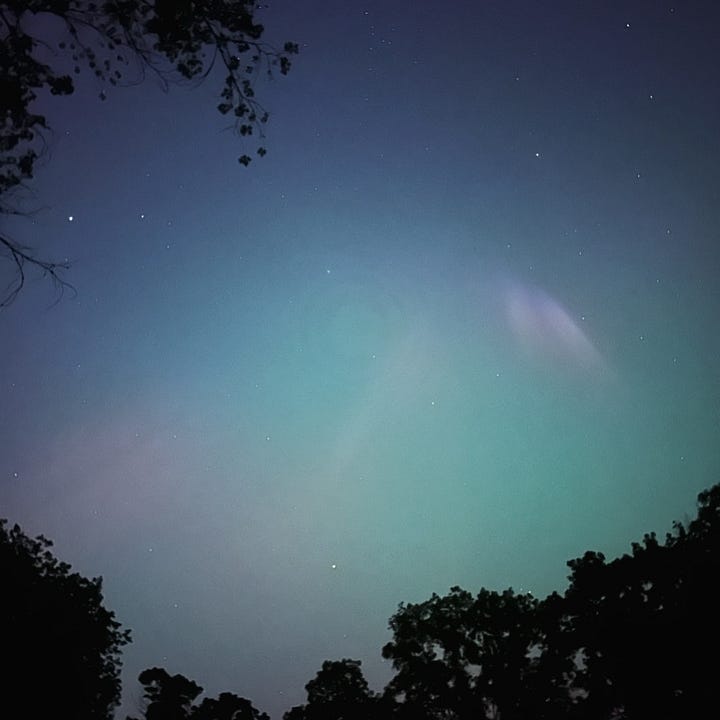
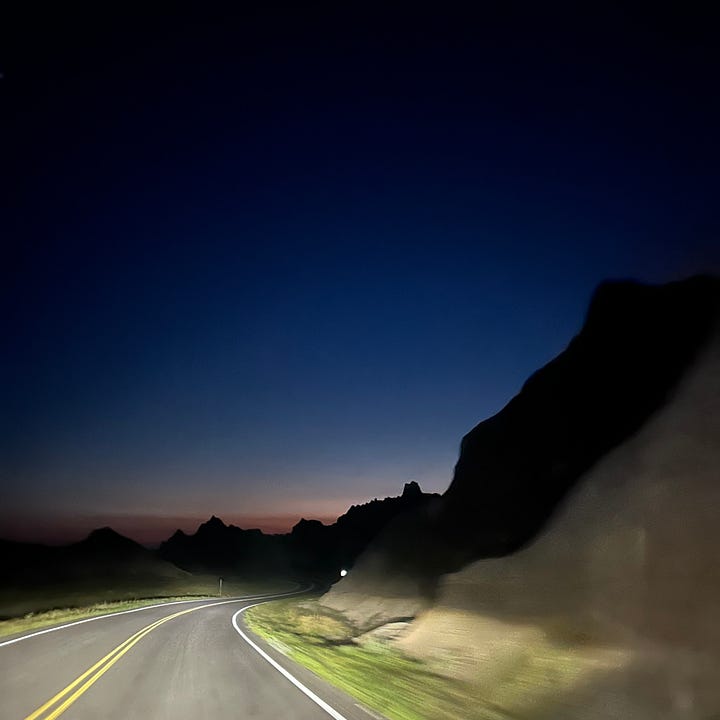
When to watch the skies
The Perseids, which are visible from July 14 to September 1, are popular among Northern Hemisphere stargazers because they’re easy to see; on the darkest nights, it’s possible to spot up to 90 meteors per hour. The Southern Delta Aquariids are best viewed from the Southern Hemisphere, though in North America it’s still possible to catch a glimpse of up to 20 meteors per hour between July 18 and August 21. Astronomers expect the Southern Delta Aquariids to peak on July 30, with the Perseids maxing out on August 12.
Limit your light exposure
Getting somewhere dark enough to catch a meteor shower can be tricky. Light pollution makes it difficult to clearly see the skies, so getting out of town helps. But it’s also important to steer clear of smaller artificial lights, too (yes, I’m talking about your phone). Last summer I attended a nighttime astronomy program in Badlands National Park and was rewarded with seeing the Milky Way in near-complete darkness. Rangers there emphasized how important it is to avoid light while stargazing; it can take 20-30 minutes for your eyes to adjust to the darkness and even longer to begin spotting the cosmos with the naked eye. Luckily, there are a few apps that turn your phone’s screen and flashlight red, which helps preserve your night vision for however long you lay out under the stars. 🔭
Arrivals, departures, and other nature notes
Should you grow this plant? You might want to mullein-it over. I love “trash” plants. You know, the weeds you rip out of your garden or mow down without a second thought. I recently learned to spot mullein (Verbascum thapsus), a common roadside bloom identifiable by its large, fuzzy leaves and vibrant yellow flowers atop 6-foot shoots. Mullein’s leaves and flowers have long been used as an herbal remedy for some lung and skin ailments, though it’s also an aggressively invasive plant brought to the U.S. from its native Europe, Asia, and northern Africa. Sometime in the mid-1700s, settlers in Virginia used mullein seeds as poison to stun and easily catch fish, helping it travel through waterways and take root across the country. Each plant can produce up to 180,000 seeds that can remain viable for a whopping 120 years.
I’m not a frogspawn, not yet a frog. Did you take a creek walk last month? You may have come across floating nests of frog and toad eggs. While many amphibians got the jump on reproduction early in the spring, I’m still finding breeding pools with smaller specimens in the weeks after the summer solstice. Most are in that transitional phase — no longer eggs and inching toward the end of their time as tadpoles. As soon as they lose their tails, they’re dubbed froglets. On average, the metamorphosis from frogspawn to adult frog takes about 14 weeks, and is a journey fraught with danger: its estimated just 1 in every 50 eggs survive to adulthood.
July 28 marks World Nature Conservation Day, highlighting the importance of protecting our natural resources. There’s a million ways to recognize the day, like picking up trash on a morning walk or swapping in a few sustainable products on your weekly grocery run. If you too experience a mean case of the Sunday Scaries, snuggling into the couch with a nature-based documentary is an option. I wholeheartedly recommend Ken Burns’ famed documentary The National Parks: America’s Best Idea (streamable on PBS’ ThinkTV platform). It’s only 12 hours long.
Nature + Media
A few recommendations of things I’ve read, watched, or listened to recently
[Listen] “Heat Can Take a Deadly Toll on Humans” from NPR’s Short Wave
We’re living in a world experiencing more frequent and severe heat waves. This 10-minute story explains how factors like humidity play a huge role in the dangers of excessive heat, and how the existing model used to calculate heat indexes may be off by as much as 28 degrees.
[Read] This Strange Wilderness: The Life and Art of John James Audubon by Nancy Plain
Did you know John James Audubon, the bird-obsessed naturalist born in 1785, was actually French? Or that he was so impoverished some relatives pretended they didn’t know him? Neither did I, though this quick read (about 100 pages, including many gorgeous illustrations) dives into Audubon’s story, which begins with something of a scandalous birth and a French Revolution near-miss. His life story also includes a strategic name change, public feuds with other ornithologists of the day, and perilous trips into the American wilderness complete with quicksand and an attempted murder.
Shameless plugs for my work around the web
Seasons change, and so do we. I recently stepped away from Optimism, a digital media brand where I spent the last four years writing about history, nature, agriculture, and food. I wrote this fun read about the history of camping during my time there.
Up next: I’m eagerly expanding into a few new publications this year, but most excited about building up Outdoor Humans over the next few months. That includes upcoming interviews with amazing folks doing interesting outdoor activities, and how you can, too. Stay tuned!
That’s it for this month’s edition of Outdoor Humans. We’ll chat again in August.
Thanks for reading, but more importantly: go get outside!
Nicole Garner Meeker


